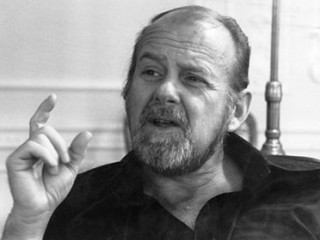
Bob Fosse biography
Date of birth : 1927-06-23
Date of death : 1987-09-23
Birthplace : Chicago, Illinois
Nationality : American
Category : Famous Figures
Last modified : 2011-01-18
Credited as : Jazz singer and dancer, musical theater choreographer, director
Legendary director/choreographer Bob Fosse is known for hits such as Sweet Charity, with its trademark jazzy number, "Hey Big Spender," and Cabaret.
Fosse's best collaboration with Verdon, Sweet Charity (1966, film 1969), demonstrated their perfect compatibility as a creative team and also flaunted his trademark style as a choreographer. Strongly influenced by choreographer Jack Cole, Fosse staged dance numbers that were highly stylized, using staccato movements and erotic suggestion. The "Steam Heat" number from The Pajama Game and "Hey Big Spender" from Sweet Charity were trademark Fosse numbers—jazzy, machinelike motion and cocky, angular, even grotesque poses. He favored style over substance (his patented knee slides and spread-finger hands), and mini-malistic costuming (all black, accentuated by hats and gloves). A perfectionist, Fosse liked detail in his choreography and would position his dancers down to the angles of their feet or their little fingers. As his career progressed, Fosse became increasingly fascinated with expressing sexuality and decadence through dance.
Fosse's peak year was 1973. In addition to his Cabaret Oscar, he nabbed Tonys for his direction and choreography of the Broadway musical Pippin, the eerily magical and sexually decadent story of the son of King Charlemagne on a journey of self-discovery. Like Cabaret, Pippin featured exaggerated, grotesque makeup and costuming and erotic dance numbers. Fosse's experiment—to place the story and music at the service of choreography—paid off when Pippin (helped by a television advertising campaign) became Fosse's longest-running Broadway show. That same year he won an Emmy for directing and choreographing Minnelli's television special Liza with a Z, which garnered high ratings and featured groundbreaking production numbers. In 1973 Fosse seemed to be everywhere.
In Lenny (1974), an exploration of the life of controversial comic Lenny Bruce, Fosse experimented with a mock-documentary filmmaking style. He identified with Bruce's attempt to liberate inhibited audiences with shocking and challenging material. Fosse suffered a heart attack while editing Lenny and rehearsing the successful Broadway musical Chicago (1975), which starred Verdon as notorious murderess Roxie Hart. Chicago was a cynical, stylized homage to 1920s-era burlesque and vaudeville. In the fascinating but disturbing film All That Jazz (1979), he used the heart attack (including a filmed bypass operation) to kill off the main character, an obsessive, womanizing, workaholic director clearly based on Fosse. His other 1970s stage musical was the innovative Dancin' (1978), which featured three acts constructed purely of dance numbers, eliminating story, song, and characters.
Fosse's work in the 1980s received mixed responses. His film Star 80 (1983) explored the violent, obsessive relationship between Playboy-model-turned-actress Dorothy Stratten and Paul Snider, the husband who brutally murdered her in 1980. Audiences and critics did not respond to the tough, gruesome subject matter. Nor did they appear to enjoy the jazz ballet Big Deal (1986), Fosse's last Broadway show. A revival of Sweet Charity in 1986 was more successful, but just as the touring company was about to be launched, Fosse died of a heart attack on 23 September 1987.
Martin Gottfried, All His Jazz: The Life and Death of Bob Fosse (New York: Bantam Books, 1990).
Kevin Boyd Grubb, Razzle Dazzle: The Life and Work of Bob Fosse (New York: St. Martin's Press, 1989).
















